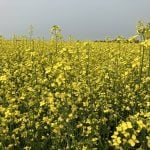(Resource News International) — Canadian spring wheat acres in 2008-09
should hold steady on the year despite earlier expectations for a
decline in seedings, according to a Canadian Wheat Board (CWB) analyst.
Spring wheat prices have overtaken oilseed values
over the past month, Bruce Burnett of the CWB’s weather and
crop surveillance department said Monday, and that makes the crop a little more favourable to
western Canadian farmers looking at strong prices for most
commodities.
Giving a market outlook during Crop Production
Read Also

U.S. grains: Corn backs away from gains at close
Chicago | Reuters — U.S. corn futures climbed to a 6-1/2 week high on Friday on short covering ahead of…
wheat acres would be down by two to five per cent from 2007-08 levels due to competition from higher-priced oilseeds. However, U.S. spring wheat futures have increased dramatically over the past
month while the rise in canola has not been as extreme, tipping
the balance back in favour of wheat.
“We’ve probably added a little more area on the wheat side,
just because of the increase in prices,” Burnett said Monday. While Burnett thought spring wheat area would now be steady
to slightly above the 15.2 million acres seeded in 2007-08, he
said there were a number of factors that will limit any expansion
of the crop.
In southern wheat growing areas there is a strong incentive
to seed durum, as durum prices have been higher for a longer
period than spring wheat, said Burnett. Durum acres
typically go up at the expense of spring wheat, he noted, forecasting that
durum seedings would be up by 25 to 30 per cent from the 4.8 million acres
seen in 2007-08.
Moving into northern and central wheat growing areas, “you
have some very strong oilseed and field pea prices,” said
Burnett. Disease and insect concerns associated with wheat will
also limit any acreage expansion, he said, plus farmers
have already increased the area seeded to winter wheat this
year.
As spring draws nearer farmers are starting to become a
little more set in their cropping decisions, said Burnett,
although he added that seeding conditions remain to be
seen, which could cause further adjustments to any acreage
expectations.















